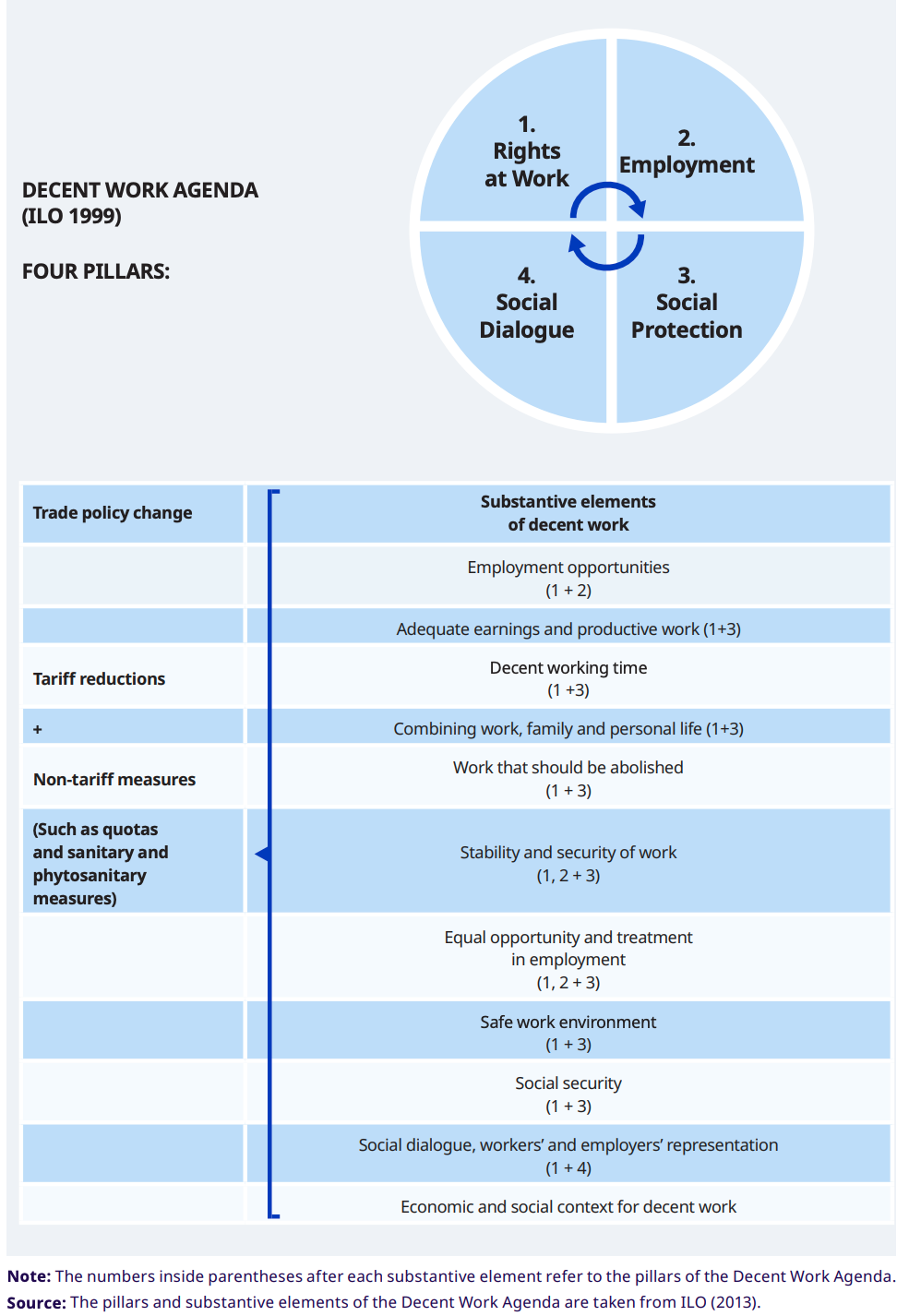Blog
Trade and decent work: the ILO’s Indicator guide (2021)

The International Labour Organization (ILO) recently published a guide addressing decent work indicators in trade policies and trade agreements. Many aspects such as employment, rights at work, social protection and social dialogue are identified as priorities in this context. This report aims to provide an assessment of the relation between trade and labour law (International Labour Organization, 2021: xi) [1]. The effects of trade on working conditions and employment are still to be adequately studied. This blog reviews the first chapter: conceptual framework: a decent work approach.
The ILO has adopted a three-step strategy to support the inclusion of labour indicators in trade policies:
-
Developing and applying a broader set of labour market indicators (which will be addressed in another blog post)
-
Linking those indicators to appropriate assessment methodologies
-
Conducting empirical analyses at the country level
(International Labour Organization, 2021: 8)
This indicator guide should therefore be read together with the ILO Handbook of Assessment Methodologies and country’s empirical analysis. The indicator guide and the handbook are described as: “a diagnostic toolkit for decent work-oriented assessments of trade” (ILO, 2021: 1). The reference to trade policies includes both tariff and non-tariff measures.
This guide, addressed to various stakeholders, is especially relevant to women and small to medium enterprises to achieve equal opportunities in the global trading system. Trade, particularly in the manufacturing sector, creates jobs for low-skilled workers including migrants, women, and youth. Many recent changes in the labour market have not been considered in existing studies, providing a justification for this guide. High-volume trade coming from international demands for products lead to intense competition in the manufacturing sector and downward pressure on working conditions. This is also amplified by the fragmentation of production, in search of cost efficiency and competitiveness, which impacts trade practices. The cheaper cost of production attracts investment, and social considerations such as labour law may well be overlooked. There is an increase of non-traditional work arrangements in the services sectors which often does not include social security coverage. This can be the result of intersectoral shifts in employment caused by trade liberalisation (ILO, 2021: 5). The important increase of short-term contracts and irregular working hours within global supply chains adds challenges to the implementation and stabilisation of labour norms. A fall in collective bargaining coverage and union density has been noticed by the ILO in recent research (Ibid.). This evolution of the labour context provides motivation for the research and development of the Indicator Guide.
As previously stated, achieving decent work for all is the main goal of this guide. However, this can be particularly difficult to achieve with trade agreements as the relative importance of different aspects of decent work can vary from country to country (ILO, 2021: 6). ILO reinforces the importance of decent work as a universal goal even when agreements are concluded between many different countries with unique economic and social context. This can be achieved through the 60 statistical indicators of the decent work framework and its different pillars. 41 ILO’s indicators were chosen for the toolkit and an additional 5 indicators were taken from the literature (ILO, 2021: 11). To select those indicators, ILO evaluated their link with trade based on theoretical and empirical evidence. Diversity within the indicators has been ensured following the framework of ILO decent work indicators itself, which gives a holistic perspective of the labour market.
This guide is meant to reach a wide audience. While focusing on the understanding of government officials, workers’ and employers’ representatives and civil society representatives, it can be relevant to students, academics, and technical experts as well.
Figure 1: Linking trade policies and substantive elements of decent work

Source: International Labour Organization
[1] International Labour Organization. 2021. Trade and decent work: Indicator guide. Geneva.
About the Author(s)
Leave a comment
The Trade Law Centre (tralac) encourages relevant, topic-related discussion and intelligent debate. By posting comments on our website, you’ll be contributing to ongoing conversations about important trade-related issues for African countries. Before submitting your comment, please take note of our comments policy.
Read more...





